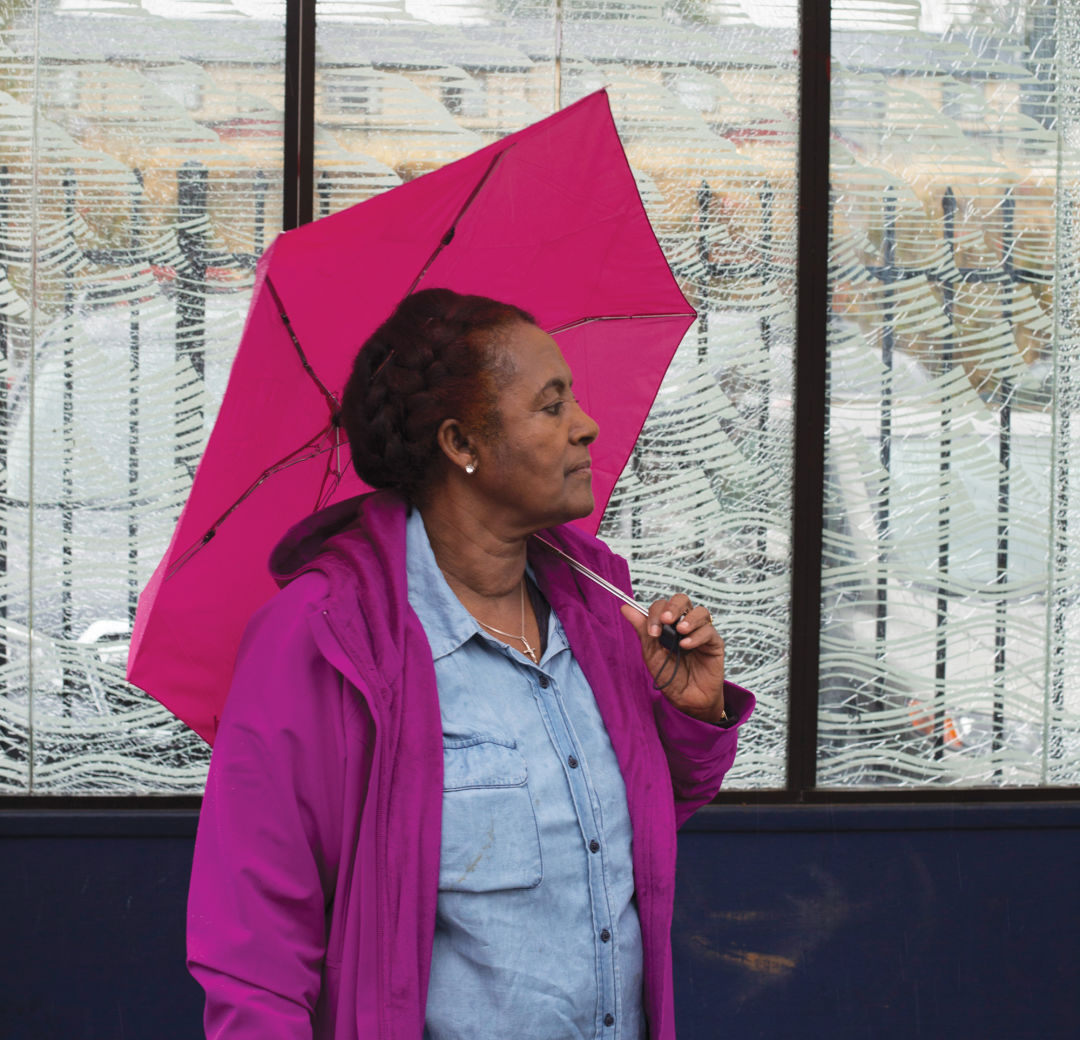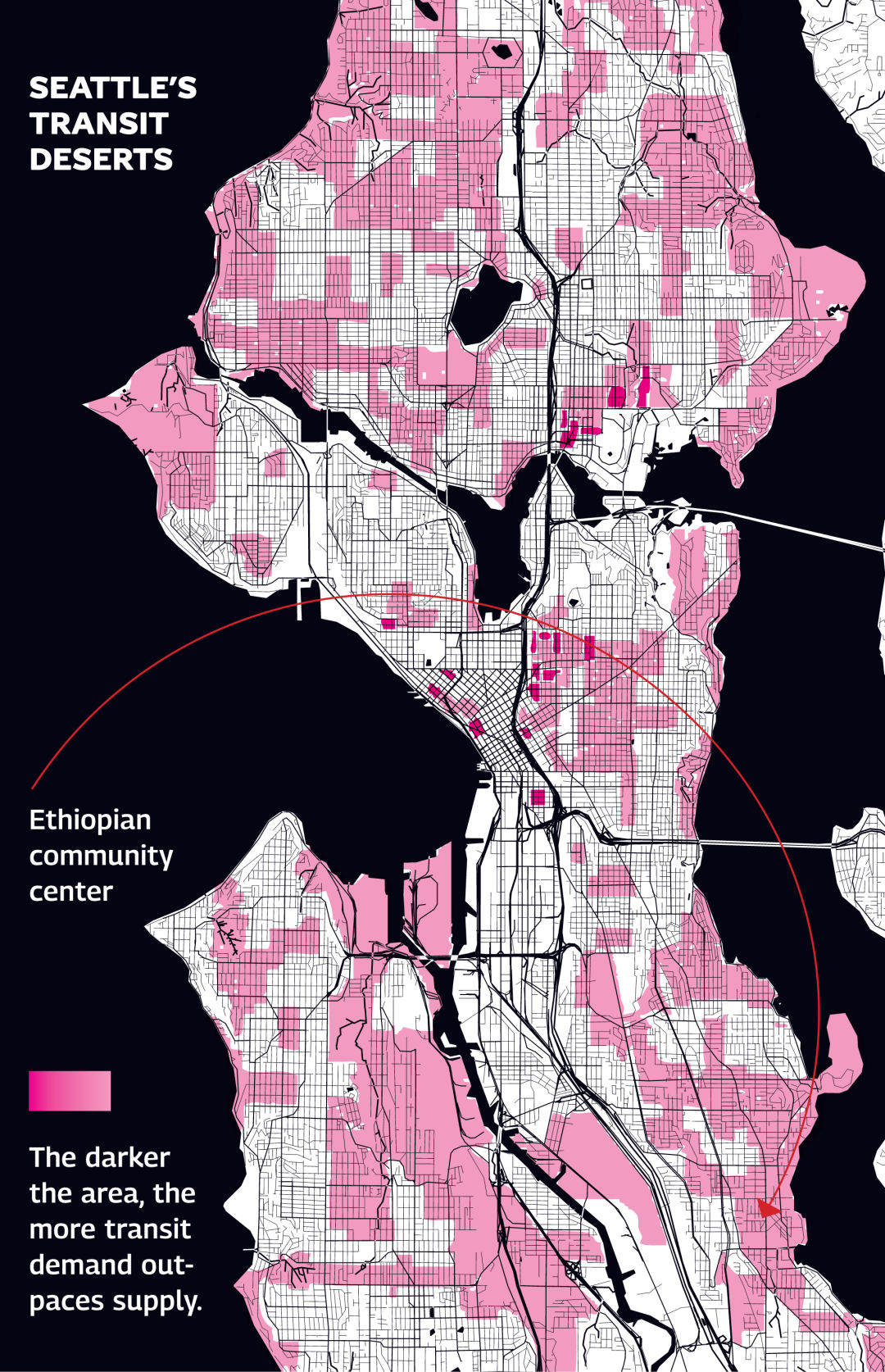Seattle Has 'Transit Deserts' and—Surprise—It's No Fun to Ride the Bus There

Melkitu Zeleke waits in Rainier Valley for the first of three buses that will take her home.
Image: David Ryder
Melkitu Zeleke knew no one in Seattle other than her son when she followed him here from Ethiopia a decade ago. After settling among immigrants in Rainier Valley, she soon found friends, and her footing, and eventually the Ethiopian Community in Seattle, a center that gave her work cooking meals for its elderly members. The center’s volunteers guided her through the tedious process to secure U.S. citizenship. Last year, its members helped her find an affordable apartment in Shoreline.
Her new home came at a different kind of cost. To get to the center she’s relied on for so long, the 61-year-old must catch three separate buses. What would otherwise be a 35-minute car ride is a two-hour journey. She visits the center less often since moving north, now only consistently dropping in for work.
“It’s difficult,” Zeleke says quietly, in broken English, “but I love the community.”
For other members of the Ethiopian community center, Zeleke’s commute—from Route 331 to the RapidRide E Line to Route 7—is familiar. The center’s director, Meron Kasahun, used to spend an hour and a half traveling there from Ballard. Members in Lynnwood must transfer between buses for nearly two and a half hours to reach the center they can no longer afford to live near. One of Zeleke’s friends, who also moved away from Southeast Seattle, stopped coming altogether.
Seattle’s Ethiopian community is not alone in the desire for better transportation options. Public transit, coupled with affordable housing, has been a growing priority for the city’s officials. When there’s a shortage of both, low-income families and people of color carry the biggest burden.
The median income for a household in Rainier Valley, a historical hub for African Americans and people of color, is $15,000 lower than the city overall, according to 2015 U.S. Census estimates. Just 29 percent of the neighborhood is white, and 16 percent of families live in poverty. A fifth of the neighborhood never finished high school. Now—after having been priced out of the Central District years earlier—African communities are being displaced again by new development. Because Rainier Valley is one of several pockets of Seattle that still have limited public transit options, commuting to the neighborhood isn’t easy.
Route 7 is one of only a few buses that travel there from downtown, Chinatown, and the International District. Most of the passengers aboard are people of color, many speaking languages other than English. The buses are older, without the amenities of RapidRide routes, such as Wi-Fi.
“It says something to the rider. It says something about the neighborhoods that bus serves and how the city approaches those neighborhoods,” says Kasahun, whose mother emigrated from Ethiopia in 1993. “There is a huge equity problem.”

11,200: The number of people who ride the Route 7 bus in King County on an average weekday.
Seattle takes pride in its public transit. About 400,000 of us ride a bus or train in King County on an average weekday. But there are still neighborhoods like the University District, which, according to University of Texas professor Junfeng Jiao, is home to the most Seattle residents who are dependent on transit but don’t have enough access to it. Rainier Valley and parts of West Seattle rank second in this category, and they’re what Jiao calls “transit deserts.” That can include people who can’t afford a car, have disabilities, or are too old to drive. And because people living in transit deserts are less mobile, that can mean fewer trips to the doctor or the grocery store.
They’re “in a significantly disadvantaged position to use the city’s infrastructure,” says Jiao, who coined the term in 2013. “To get a job, to support a family, to maintain a good mental health status.”
By contrast, areas like Alki Beach, Interbay, and Columbia City—just north of Seward Park—are well connected. King County Metro’s service planning supervisor, Katie Chalmers, says the agency often reaches out to riders and adjusts routes based on feedback; complaints about a lack of east-west connections in Seattle, for example, led the county to extend Route 50, which winds from Southeast to West Seattle.
South Seattle still remains isolated, with long commute times even to reach downtown. Many residents have relocated to Tukwila or Renton, but community center members have moved all over. Gentrification in the valley, as elsewhere, has spawned a mini diaspora.
“I don’t think we really anticipated the amount of migration that’s going to be occurring,” Kasahun says.
More commuters means more demand for public transit. Voters last year approved a $54 billion transportation levy to expand the public transit system. Metro’s 2017–18 budget earmarked $30 million to beef up bus service.
Still, routes are typically concentrated downtown. History and topography have also played a role. When diesel buses replaced the trolley system in the 1970s, they followed the same downtown routes established in the 1940s. Today, most of the city’s jobs are based downtown, according to the county, and that’s where demand is the greatest.
In Rainier Valley, about 10,400 residents south of Seward Park are transit dependent, according to Jiao’s research. Route 7 is now the fifth most popular in the county but Metro won’t introduce a speedier RapidRide line for the area until 2021.
“As much as we are able to invest, and as much as ridership is growing in the city, there’s still so much more that we could do,” says Andrew Glass Hastings, director of transit planning for the Seattle Department of Transportation. “The demand out there is almost insatiable.”
City council members have long debated whether investments in projects like the Seattle Streetcar would be better spent on mass transit. New light rail stations in Rainier Valley caused controversy because their at-grade crossings—railway lines that cross a road at the same level—posed public safety risks.
“A lot of people still think that the South End is invisible,” says Susan Davis, who heads the Rainier Chamber of Commerce. “I think maybe we don’t have enough loud voices here.”
As more of the East African community in Rainier Valley is displaced, the dearth of public transportation options in the area becomes more acute. The Rainier Beach light rail station, which opened in July 2009, is a boon, but members of the Ethiopian community center must still ride Route 7 for 20 minutes to get there.
Fikru Kifle, a longtime member of the center, says not all the changes have been bad. The 71-year-old recalls when he regularly heard gunshots in the morning. Safety has improved since he emigrated from Ethiopia and arrived in Rainier Valley in 1980. He sold his house and moved to Wallingford 14 years ago but still considers the old neighborhood his home—the cheap Brighton apartments where many East Africans lived, his favorite bar in Columbia City that was replaced by a restaurant and then a furniture store.
He visits the community center at least three times a week, after a bus trip that sometimes takes nearly two hours each way. On one chilly October afternoon, he sat in the lobby in a gray suit, holding a glass of hot tea as he greeted regulars who came over to shake his hand and salute him in Amharic, one of the languages spoken in Ethiopia.
“This is a place where we try to preserve our heritage, our culture, and pass it on to the young generation,” Kifle says.
He’s worried about what they’ll lose if they stop coming.
After a couple summers traveling to Rainier Valley by bus, the center’s director, 24-year-old Kasahun, saved up for the car she now drives to work. She doubts she would have continued commuting without it.
Kasahun and the center’s leaders still hold hope for members who can no longer afford to live in the neighborhood. A new proposed complex would replace the current building and include 100 units of low-income housing.
The new lodging would be a welcome addition for Melkitu Zeleke, the cook at the center whose interminable commute to and from Shoreline is nearly as long as her shift. For now she serves the stew she makes there with a gentle smile. Wearing a blue shawl beneath her white apron, she bakes injera, a traditional flatbread, and passes out the spongy, gray sourdough on paper plates.
Asked whether she owns her new place in Shoreline, she laughs. “I cook once a week,” she says. She laughs harder. “Not enough to buy a house.”
Though she loves the new apartment, she wants to return to the South End. She’s worried about the community center’s future. Eventually, she thinks, gentrification will hamper its membership—if it hasn’t already.
The center’s new housing won’t be built for another few years, but when it’s completed, Zeleke’s ready to move back. With a shorter commute, she would visit the center for more than work. She could again spend her free time in the community that made her new country feel like home.




